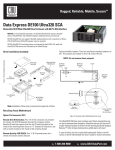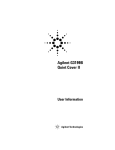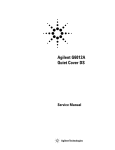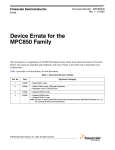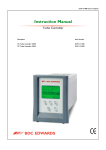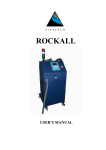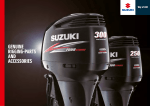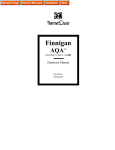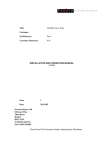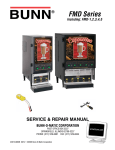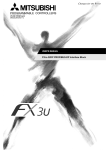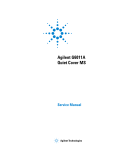Download Agilent G3199 Series Quiet Cover Service Manual
Transcript
Agilent G3199 Series Quiet Cover Service Manual Agilent Technologies Notices © Agilent Technologies, Inc. 2011 No part of this manual may be reproduced in any form or by any means (including electronic storage and retrieval or translation into a foreign language) without prior agreement and written consent from Agilent Technologies, Inc. as governed by United States and international copyright laws. Manual Part Number G3199-90020 Edition Third edition, December 2011 Second edition, May 2007 First edition, April 2005 Safety Notices CAUTION A CAUTION notice denotes a hazard. It calls attention to an operating procedure, practice, or the like that, if not correctly performed or adhered to, could result in damage to the product or loss of important data. Do not proceed beyond a CAUTION notice until the indicated conditions are fully understood and met. Printed in USA Agilent Technologies, Inc. 2850 Centerville Road Wilmington, DE 19808-1610 USA WA R N I N G A WARNING notice denotes a hazard. It calls attention to an operating procedure, practice, or the like that, if not correctly performed or adhered to, could result in personal injury or death. Do not proceed beyond a WARNING notice until the indicated conditions are fully understood and met. 2 Service Manual Contents 1 2 Introduction Parts Identification 6 Safety Information 9 Replacement Procedures Preparing Quiet Cover for Repair Replacing a Fan 16 Replacing the Alarm 19 Replacing the Thermostat 21 Replacing the On/Off Switch Replacing an LED Service Manual 22 23 Replacing the Wiring Harness 3 14 24 Replaceable Parts 3 4 Service Manual Agilent G3199 Series Quiet Cover Service Manual 1 Introduction Parts Identification 6 Safety Information 9 This manual provides information for Agilent service representatives to support the Agilent G3199A Quiet Cover and G3199B Quiet Cover II. The G3199A is compatible with the BOC Edwards E1M18 pump used with the Agilent 1100/1200 LC/MS Series instruments. The G3199B is compatible with the BOC Edwards E1M18 and E2M28 pumps used with the Agilent 1100/1200 LC/MS Series instruments and with the BOC Edwards E2M18 pump used with the Agilent ICP/MS. Agilent Technologies 5 1 Introduction Parts Identification Figures 1- 4 point out the main components of the internal Quiet Cover. Fan G1099-60564 Alarm: G3199A: 5188-1177 G3199B, s/n USxxxxxxx: 5188-1177 G3199B, s/n SGxxxxxxx: 5188-1277 Fan cable Fan connector Thermostat: G3199A: 5188-1176 G3199B: 5188-6570 Power connector (included in wiring harness) Wiring harness: G3199A: 5188-1163 G3199B, s/n USxxxxxxx: 5188-1163 G3199B, s/n SGxxxxxxx: G3199-60000 Figure 1 6 Quiet Cover (internal view of rear panel). (Alarm 5188-1177 and wiring harness 5188-1163 shown.) Service Manual Introduction 1 On/off switch 5188-1178 Power (green) 5188-1180 Ferrite (part of wiring harness 5188-1163 or G3199-60000) Temperature alarm (red) LED 5188-1179 Figure 2 Quiet Cover (internal view of front panel). Wiring harness 5188-1163 Figure 3 Service Manual Internal view showing rear part of wiring harness. 7 1 Introduction Wiring Wiringharness harness Figure 4 8 Internal view showing front part of wiring harness. Service Manual Introduction 1 Safety Information General Information The Quiet Cover conforms to the International Electrotechnical Commission (IEC) 61010–1 safety standard. It also conforms to the following regulations on Electromagnetic Compatibility (EMC) and Radio Frequency Interference (RFI): • CISPR 11/EN 55011: Group 1, Class A • IEC/EN 61326 • AUS/NZ This ISM device complies with Canadian ICES- 001. Cet appareil ISM est conforme a la norme NMB—001 du Canada. The Quiet Cover is designed and manufactured under a quality system registered to ISO 9001. Information The Agilent Technologies Quiet Cover meets the following IEC classifications: Category II, Pollution Degree 2, Class III. Quiet Cover has been designed and tested in accordance with recognized safety standards and is designed for use indoors. If it is used in a manner not specified by the manufacturer, the protection provided by the instrument may be impaired. Whenever the safety protection of the Quiet Cover has been compromised, disconnect it from all power sources and secure it against unintended operation. Refer servicing to qualified service personnel. Substituting parts or performing any unauthorized modification to the instrument may result in a safety hazard. Service Manual 9 1 Introduction Symbols Warnings in the manual or on the instrument must be observed during all phases of operation, service, and repair of this instrument. Failure to comply with these precautions violates safety standards of design and the intended use of the instrument. Agilent Technologies assumes no liability for the customer’s failure to comply with these requirements. Table 1 lists the safety symbols that may appear on Quiet Cover. Table 1 Safety symbols Description Symbol See accompanying instructions for more information. Indicates a hot surface. Pinch hazard. Indicates earth (ground) terminal. Indicates that you must not discard this electrical/electronic product in domestic household waste. Important Safety Warnings Safety cautions and warnings must be observed during all phases of operation, service, and repair of Quiet Cover. Failure to comply with these precautions violates safety standards of design and Quiet Cover’s intended use. Agilent Technologies assumes no liability for the customer’s failure to comply with these requirements. WA R N I N G 10 Never run the pump without also running Quiet Cover. Service Manual 1 Introduction CAUTION While running Quiet Cover: • Do not block air flow to the fans. • Do not set items on top of Quiet Cover. • It is important that the Quiet Cover not recirculate hot air. Always position the front end of the Quiet Cover where it can draw cool air. CAUTION Be sure to position Quiet Cover so that there is plenty of room to allow access to panels and controls. WA R N I N G In the event of a temperature alarm malfunction or if the alarm has been on for an extended period of time, Quiet Cover and the pump may be dangerously hot. Check that the Quiet Cover and pump are cool before you touch them. Electromagnetic compatibility This device complies with the requirements of CISPR 11. Operation is subject to the following two conditions: • This device may not cause harmful interference. • This device must accept any interference received, including interference that may cause undesired operation. If this equipment does cause harmful interference to radio or television reception, which can be determined by turning the equipment off and on, the user is encouraged to try one or more of the following measures: • Relocate the radio or antenna. • Move the device away from the radio or television. • Plug the device into a different electrical outlet, so that the device and the radio or television are on separate electrical circuits. • Make sure that all peripheral devices are also certified. • Make sure that appropriate cables are used to connect the device to peripheral equipment. Service Manual 11 1 Introduction • Consult your equipment dealer, Agilent Technologies, or an experienced technician for assistance. • Changes or modifications not expressly approved by Agilent Technologies could void the user’s authority to operate the equipment. Sound emission declaration • Sound pressure – Lp < 70 dB am according to EN 27779:1991. • Schalldruckpegel – LP < 70 dB am nach EN 27779:1991. 12 Service Manual Agilent G3199 Series Quiet Cover Service Manual 2 Replacement Procedures Preparing Quiet Cover for Repair 14 Replacing a Fan 16 Replacing the Alarm 19 Replacing the Thermostat 21 Replacing the On/Off Switch 22 Replacing an LED 23 Replacing the Wiring Harness 24 Agilent Technologies 13 2 Replacement Procedures Preparing Quiet Cover for Repair Before performing any replacement procedures on the Quiet Cover, prepare it for service as described below. Required tools • 5/16- inch open- end wrench Procedure 1 Turn off and unplug Quiet Cover. 2 Remove the two pump access panels by loosening the thumbscrews on the top and sides. 3 Remove the lid by loosening the three thumbscrews along the bottom of each side and by loosening the one thumbscrew along the front edge of each side. WA R N I N G The pump: • May be hot. Use gloves when moving it or wait until it is cool. • Is heavy. For your safety, two people should move it together. 4 Remove the pump. a Remove the nuts from the vibration mounts. b Slide the cord and grommet from the groove in the back upper edge of the Quiet Cover frame. (See Figure 5.) Power cord grommet Figure 5 14 Power cord grommet. Service Manual Replacement Procedures 2 c Remove the grommet from around the cord and slide the grommet back into the groove in the frame for safekeeping. d Pick up the pump and remove it from Quiet Cover. Use two people to lift the pump. e Loosely thread the nuts back onto the vibration mounts for safekeeping. NOTE Service Manual Do not forget to replace the pump, lid, and pump access panels when maintenance is complete. 15 2 Replacement Procedures Replacing a Fan Required tools • Phillips screwdriver • A wrench for #8–32 nut Procedure To remove the old fan 1 Perform the steps under “Preparing Quiet Cover for Repair” on page 14. 2 Disconnect the fan cable at the fan connector of the wiring harness. (See Figure 6.) Disconnect here Fan connector Figure 6 16 Disconnecting the fan. Service Manual Replacement Procedures 2 3 Remove the baffle (metal plate covering the fans on the outside of the Quiet Cover). There are six screws that hold it in place. (See Figure 7.) Hold the standoffs behind the baffle to prevent them from turning. Figure 7 Rear baffle, showing its six screws. 4 Remove the four screws and nuts from the faulty fan. (See Figure 8.) Remove Figure 8 Removing the fan. 5 Remove the fan and finger guards. Save the finger guards. To install the new fan 1 Orient the new fan so the cable is at the bottom and the airflow will be directed out of: • The back of the Quiet Cover (G3199A) • The front of the Quiet Cover II (G3199B) Service Manual 17 2 Replacement Procedures 2 Place the outside finger guard (with the countersunk screw holes facing out) on the outside of the Quiet Cover. 3 Feed one screw, with the white insert facing out, through the outer finger guard and the Quiet Cover wall. 4 Install a fan spacer into the fan, and slide the screw all the way in. Then install the fan and inside finger guard (countersinks facing fan) over the screw. Install the remaining screws and spacers. (See Figure 9.) Spacer Fan Inner finger guard Figure 9 Fan, showing mounting-screw after assembly 5 Add and tighten the nuts. 6 Connect the fan cable to the fan connector of the wiring harness. 7 Reinstall the baffle. 18 Service Manual Replacement Procedures 2 Replacing the Alarm About alarm connectors Two models of alarms are used in the G3199 Series Quiet Covers. All G3199A and any G3199B Quiet Covers with serial number USxxxxxxx use an alarm and wiring harness with blade connectors. Any G3199B Quiet Cover with serial number SGxxxxxxx uses an alarm and wiring harness with screw- on wire connectors. Required tools • None for blade connector alarm type. • Philips screwdriver for screw connector alarm type Procedure 1 Perform the steps under “Preparing Quiet Cover for Repair” on page 14. 2 Remove the wires (marked ALRM + and ALRM –) from the alarm. (See Figure 10.) Connectors Alarm with blade connectors 51288-1177 Alarm with screw connectors 51288-1277 Figure 10 Inside view of the back of alarm. Service Manual 19 2 Replacement Procedures 3 From the outside of the Quiet Cover, unscrew the ring securing the alarm and remove the alarm. (See Figure 11.) Figure 11 Outside view of the alarm. 4 Screw a new alarm into place. 5 Reconnect the wires to the alarm, matching the ALRM + and ALRM – wires to the + and – terminals on the alarm. 20 Service Manual 2 Replacement Procedures Replacing the Thermostat Required tools • Phillips screwdriver Procedure 1 Perform the steps under “Preparing Quiet Cover for Repair” on page 14. 2 Remove the two wires THERM-1 and THERM-2 from the thermostat. G3199A part number 5188-1176 G3199B part number 5188-6570 Figure 12 Thermostat. 3 Remove the two screws that hold the thermostat in place, and remove the thermostat. (See Figure 12.) 4 Place the new thermostat (G3199A part number 5188- 1176; G3199B part number 5188- 6570) on the thermostat studs. The left/right orientation is not important. Reinstall the two screws that hold the thermostat. 5 Attach the wires marked THERM-1 and THERM-2 on the wiring harness to the connectors on the thermostat. It does not matter which wire is attached to which side of the thermostat. Service Manual 21 2 Replacement Procedures Replacing the On/Off Switch Required tools None Procedure 1 Perform the steps under “Preparing Quiet Cover for Repair” on page 14. 2 Inside the cabinet remove the two wires SW-1 and SW-2 from the on/off switch. (See Figure 13.) Remove wires Figure 13 Wires to remove from the on/off switch. 3 Squeeze the latches on the back of the switch and push it out through the front of the Quiet Cover. 4 Toggle the new switch so the red does not show. 5 With the raised end of the switch at the top, push the new switch in place. (The two wiring connectors will be towards the bottom of the switch, see Figure 13.) 6 Connect the SW-2 wire from the wiring harness to the top connector of the switch and the SW-1 wire to the bottom connector. 22 Service Manual Replacement Procedures 2 Replacing an LED Required tools • A wrench for #6–32 nut Procedure 1 Perform the steps under “Preparing Quiet Cover for Repair” on page 14. 2 Remove the + and – wires (marked GLED+/– or RLED+/–) from the faulty LED. (See Figure 14.) Metal LED holder Green LED Screw Ferrite Remove wires Red LED Figure 14 LED connectors. 3 Remove the nut that secures the metal LED. 4 Remove the faulty LED and replace it with a new one. 5 Replace the metal LED holder, making sure that both LEDs and the nylon holder for the ferrite are in place. 6 While holding the metal LED holder, secure it with the nut. Check once again that the ferrite in the wire holder is still attached to the back of the LED holder. 7 Reattach wires to the replacement LED. Hold the LED firmly so that the connectors do not bend. • If replacing the red LED, connect the RLED+ wire to the red + connector tab and the RLED– wire to the red – connector tab. • If replacing the green LED, connect the GLED+ wire to the green + connector tab and the GLED– wire to the green – connector tab. Service Manual 23 2 Replacement Procedures Replacing the Wiring Harness Required tools • Pliers with wire cutter • Phillips screwdriver Procedure To remove the old wiring harness 1 Perform the steps under “Preparing Quiet Cover for Repair” on page 14. 2 Disconnect the wiring harness connections for the alarm, fans, thermostat, on/off switch, and LEDs. Loosen and remove the nut retaining the grounding wire. (This is located below the thermostat.) 3 Remove the ferrite from the nylon holder. 4 Cut the red 24+ and the green 24– wires from the power connector on the inside back of the Quiet Cover. Remove the old wiring harness, slipping the wires out of each of the nylon holders. 5 Remove the four screws from the power connector on the outside of the Quiet Cover (bottom back). Save the screws; you will reuse them when connecting the new power connector. (See Figure 15.) Figure 15 Power connector (outside view). 6 Remove the power connector. 24 Service Manual 2 Replacement Procedures To connect the new wiring harness 1 Install the new power connector into the back of the Quiet Cover using the same screws as before. Pinhole 1 should be on the top inside and pinhole 4 should be on the bottom. (Pinholes 2 and 3 are horizontal from each other and used for the electrical connection in step 4.) 2 Place the new wiring harness along the side rail of the Quiet Cover, with the ferrite end at the front of the box. 3 Slide the wires into the nylon wire holders along the inside of the rail. 4 Connect all the wiring as indicated below: • Power connector. Insert the red 24+ wire into pin 2 and the black 24– wire into pin 3 of the power connector on the inside of the Quiet Cover. (See Figure 16.) Figure 16 Connecting the power connector on the inside of the Quiet Cover. • Thermostat. On the inside back of the Quiet Cover, attach the THERM-1 and the THERM-2 wires to the two thermostat connector tabs. • Alarm. Attach the ALRM + wire to the + side of the alarm connector tab and the ALRM – wire to the – side of the alarm. • Fans. Connect both fans. • Ferrite. Slide the wires of the ferrite into the wire holder attached to the center of the LED holder. Then, slide the ferrite into the holder so it is held firmly in place next to the LED holder. • LEDs. Connect the + and – wires (marked GLED +/– and RLED +/–) to the green and red LEDs, respectively. • On/off switch. Connect the SW-2 wire to the top switch connector tab and the SW-1 wire to the bottom connector tab. Service Manual 25 2 Replacement Procedures 5 Verify that the oil tray does not pinch any of the wires when sliding the oil tray in and out of the Quiet Cover. 26 Service Manual Agilent G3199 Series Quiet Cover Service Manual 3 Replaceable Parts Table 2 lists the G3199 Series Quiet Cover’s replaceable parts. Table 2 Replaceable parts Part Part number Casters Locking front caster (G3199A) 5188-1173 Non-locking back caster (G3199A) 5188-1174 Caster (G3199B) 5188-6571 Electrical On/off switch 5188-1178 Fan G1099-60564 Red LED 5188-1179 Green LED 5188-1180 Alarm G3199A G3199B with serial number USxxxxxxx G3199B with serial number SGxxxxxxx 5188-1177 5188-1177 5188-1277 Thermostat G3199A G3199B 5188-1176 5188-6570 Agilent Technologies 27 Agilent Technologies Table 2 Replaceable parts (continued) Part Part number Wiring harness G3199A G3199B with serial number USxxxxxxx G3199B with serial number SGxxxxxxx 5188-1163 5188-1163 G3199-60000 Power supply 5188-1164 Other parts Oil tray 5188-1184 Mist filter extension 5188-1181 Clamp for mist filter extension 0100-0549 Seal for mist filter extension 0100-1597 Pin extraction tool (for power connector) 8710-0614 © Agilent Technologies, Inc. 2011 Third edition, December 2011 Printed in USA




























